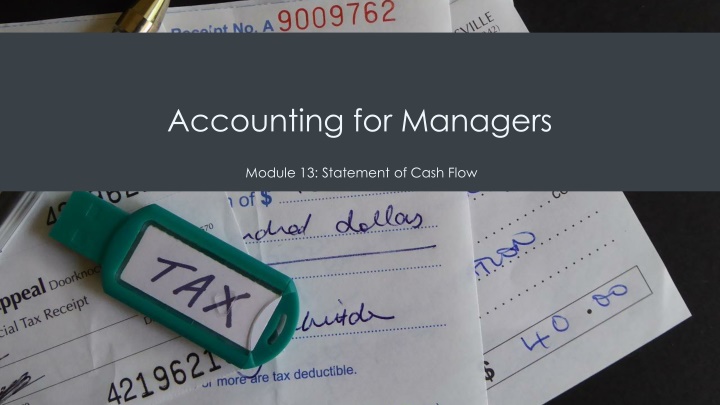
Accounting for Managers
Learn key concepts in cash flows, non-cash activities, operating activities, investing activities, and financing activities. Explore the direct and indirect methods of preparing a cash flow statement for effective financial management.
Download Presentation

Please find below an Image/Link to download the presentation.
The content on the website is provided AS IS for your information and personal use only. It may not be sold, licensed, or shared on other websites without obtaining consent from the author. If you encounter any issues during the download, it is possible that the publisher has removed the file from their server.
You are allowed to download the files provided on this website for personal or commercial use, subject to the condition that they are used lawfully. All files are the property of their respective owners.
The content on the website is provided AS IS for your information and personal use only. It may not be sold, licensed, or shared on other websites without obtaining consent from the author.
E N D
Presentation Transcript
Accounting for Managers Module 13: Statement of Cash Flow
Non-Cash Activities In order to prepare cash flow statement, we need to understand which items on income statement and balance sheet may not involve transfer of cash Non-cash activities include depreciation, amortization, & obsolescence Non-cash items need to be properly recorded on income statement but disregarded on cash flow statement Cash and cash equivalents are items on balance sheet that are liquid assets Cash equivalents include money market accounts, & treasury bills, and are easy to move to checking account if cash is needed
Operating Activities Two methods to compute cash flow statement: direct and indirect Several sections on cash flow statement First section, operating activities: transactions that happen in normal course of business, affecting revenue and expense accounts on income statement Inflow is the money in, and outflow is money going out Portion of cash flow statement can help better understand the need to have effective accounts receivable system Cash budget: important to financial health of companies
Investing Activities The second section of the cash flow statement involves investing activities. We will again be chatting about inflows and outflows as it relates to investments.\ If you invest in property, plant, equipment, stocks, bonds or another company, these are all investment activities on your cash flow statement.
Financing Activities Third part of cash flow statement involves financing activities Some inflows from financing activities (borrowing money or selling common stock) and outflows (paying principal part of debt, buying back stock, paying dividend)
The Indirect Method Companies mostly use direct method, however indirect method is important Starts with net income and adds or subtracts items based on changes in their balances Related accounts on balance sheet for when changes happen and how they affect statement of cash flows
The Direct Method Starts with income statement and rebuilds it on the cash basis most companies operate on accrual basis where income is recognized when earned & expenses when they occur Method typically used Wouldn t be concerned with changes in accounts receivable balance
Net and Gross Cash Flows Gross cash flows don t exist in operating portion of cash flow statement, instead for investing and financing Includes purchase price in cash of new piece of property or equipment and cash gain of sale of piece of property or equipment
Net and Gross Cash Flows: Table Assets and Liabilities If the account balance increases If the account balance decreases Non-current assets (Investing activities) Property, Plant, and Equipment (P, P & E) Subtract Add Long-term investments Subtract Add Loans to others Subtract Add Liabilities and Equity (Financing Activities) Bonds payable Add Subtract Common stock (our own company) Add Subtract Retained earnings * *
Steps for Preparing a Statement of Cash Flow Indirect method is working from bottom of income statement and adjusting it to the cash basis take net income first and work from there First step is to add back depreciation (non-cash expense) Second step is to analyze net changes in balance sheet accounts
Cash Flow Analysis Once customer acquisition process and collection procedures are corrected, cash flow will improve, bills will be paid on time, and cash balance will be positive Easy to see how important analyzing cash flow is and how it can improve business processes Can also look at forecasted cash flow to help us see where our company is at from a cash standpoint Forecasted cash flow statement can be created based on historical data or from budgeted amounts
Quick Review Importance of cash flow analysis and forecasting cannot be stressed enough Direct (takes income statement to cash based format) and indirect (starts with net income and adds and subtracts items from income statements) methods Depreciation is added back as it is a non-cash expense, then account is analyzed to come to net change in cash Great resources with templates and assistance in preparing cash flow statements
